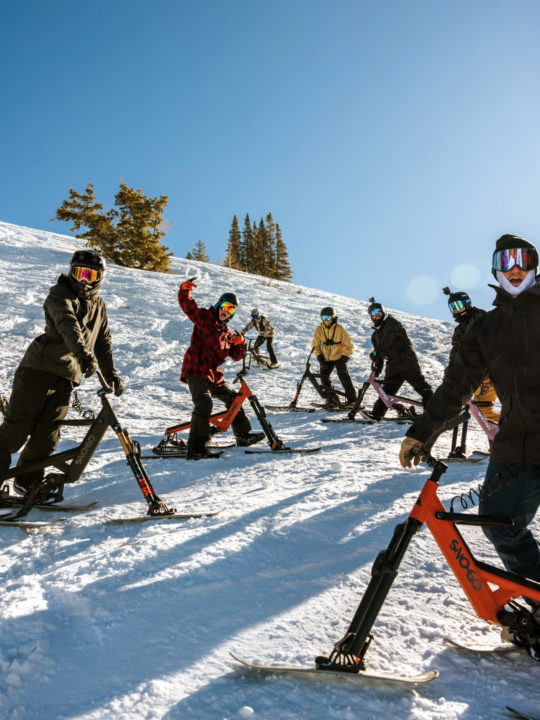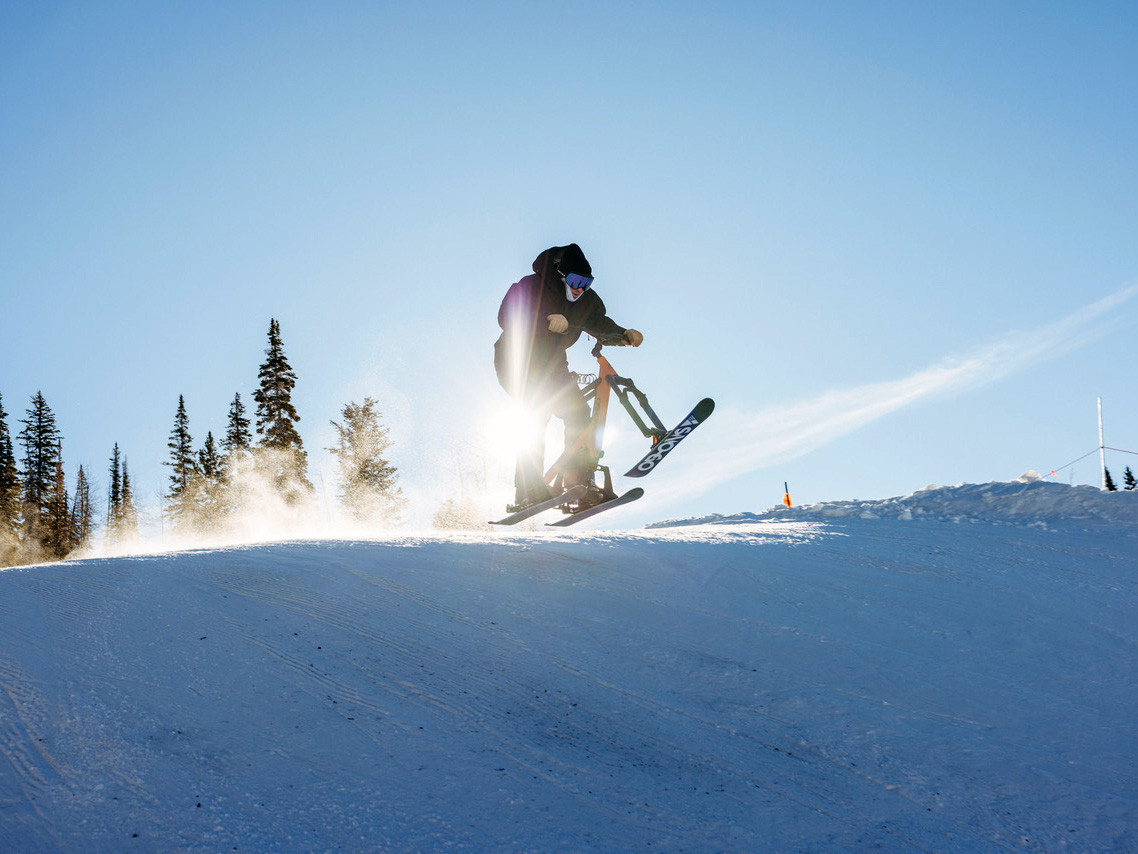Experiencing the thrill of fresh snow in Colorado is always a treat. Having spent countless days carving through powdery slopes on skis and navigating mountain trails on my bike, I thought I had experienced winter sports from every angle. That was until I strapped into a Sno-Go bike at Winter Park on a crisp, post-snowstorm weekday. While Winter Park’s renowned slopes were as inviting as ever, this time, my equipment was decidedly different – trading traditional skis for three, and poles for handlebars. This was my introduction to ski biking, specifically on a Sno-Go rig, expertly fitted at the Sno-Go Ride Center at Winter Park, a premier destination for anyone curious about this exciting snow sport.
“Just lean forward, and you’ll get the hang of it,” advised Chase Wagstaff, cofounder of Sno-Go, as he effortlessly carved turns beside me. Wagstaff was at Winter Park, guiding newcomers like myself, demonstrating the intuitive movements of the ski bike with fluid shifts from edge to edge. Winter Park, recognizing the growing appeal of ski biking, even offers guided Sno-Go tours with dedicated instructors, making it easier than ever to learn. My fortunate introduction included Wagstaff himself, providing invaluable insights into the basics of Sno-Go biking.
Ski bikes are gaining traction across ski resorts, offering a fresh perspective on snow riding. While various ski bike designs exist, including two-ski models favored by advanced riders from brands like SkiByk and Lenz, the Sno-Go stands out with its unique tricycle-like geometry. Founded in 2016 by Wagstaff and his partner, Sno-Go bikes feature a front ski mounted on a suspension fork, similar to a mountain bike, and rear skis that pivot parallel to the frame.
This wider, three-ski platform provides enhanced stability, making the Sno-Go remarkably beginner-friendly, much like training wheels on a bicycle. Controlling speed and stopping is achieved by steering uphill or using subtle hip movements to scrub speed. A thoughtful design feature of the Sno-Go is its integrated hang bar, simplifying chairlift loading and unloading – a welcome contrast to other ski bikes that often require awkward lifting and balancing.
 Riding Sno-Go ski bikes at Winter Park
Riding Sno-Go ski bikes at Winter Park
Image alt text: Sno-Go ski bikers enjoy a sunny day riding down groomed slopes at Winter Park, Colorado.
However, the Sno-Go isn’t just for beginners. Despite its user-friendly nature, this ski bike offers experienced riders a high-performance experience. The three points of snow contact allow for quicker turns and greater control, enabling skilled riders to navigate glades and moguls with impressive speed and precision, surpassing even traditional ski bikes. Expert riders, like Wagstaff himself, demonstrate the Sno-Go’s versatility by tackling terrain parks and executing tricks, pushing the boundaries of what’s possible on a ski bike.
Wagstaff continued to offer guidance, emphasizing, “Engage your edges and maintain balanced weight distribution. Really drive into that downhill leg – that’s when you truly start to command the Sno-Go.”
Wearing snowboard boots, I secured my right foot into the binding, pushed off with my left, and then locked in my other foot – the bindings reminiscent of classic toe clips. Moments later, I was gliding down the gentle slope, carving fluid turns across the groomed snow, leaving delicate plumes of snow in my wake.
The learning curve was surprisingly gentle. Soon, I was confidently arcing turns, weaving through the spruce and pine forest bordering the run. Experimenting with jumps and spins, I managed a few effortless 180s – the Sno-Go, weighing just over 30 pounds, felt remarkably nimble. Front and rear shocks absorbed bumps in the firm snow, boosting my confidence to increase speed – this machine was undeniably fun.
Perhaps a bit too much confidence, as a momentary lapse in focus – turning my head without properly aligning my body – resulted in a fall, reminiscent of losing control on a mountain bike turn. Fortunately, the snow provided a forgiving landing, although a sharp impact to my shin against the bike’s frame served as a reminder of the terrain. The Sno-Go’s leash kept it securely nearby, allowing me to quickly remount and continue down the slope.
The Sno-Go ski bike delivered a sensation akin to skiing, yet the body positioning and balance felt remarkably similar to mountain biking. It perfectly fulfilled that mountain biking craving that surfaces during the winter months. I began to envision the fun of a group ride with friends, exploring the slopes together on Sno-Go bikes.
 Riding Sno-Go ski bikes at Winter Park
Riding Sno-Go ski bikes at Winter Park
Image alt text: A close-up shot of a Sno-Go ski bike rider carving a turn on a sunny day at Winter Park, showcasing the bike’s maneuverability.
Winter Park isn’t the only Colorado resort embracing ski bikes. Nearby Keystone, along with Aspen and Eldora, also permit them on lifts. Wagstaff estimates around 20 ski areas in Colorado and 250 across North America welcome ski bikes, with interest rapidly expanding. “Millions are discovering Sno-Go right now,” he noted, emphasizing their efforts to expand Sno-Go availability at more resorts and introduce more people to ski biking.
While Winter Park hosts Colorado’s exclusive Sno-Go Ride Center, offering rentals, lift tickets, and lessons in one convenient location, other ski bikes are welcome on the mountain. If you rent a ski bike from Aspen Ski Bike, Colorado Ski Bikes, or a Lenz distributor, you can use it at Winter Park with a standard lift pass. Similar policies are in place at other Colorado resorts, though it’s always recommended to verify beforehand.
Reaching the bottom of the slope, I was genuinely thrilled and eager to tackle a blue run. The Sno-Go bike had opened up a new dimension of winter fun, blending the familiar sensations of skiing and mountain biking into an exhilarating snow sport experience.
 Riding Sno-Go ski bikes at Winter Park
Riding Sno-Go ski bikes at Winter Park
Image alt text: A group of Sno-Go ski bikers pause on a snowy slope at Winter Park, enjoying the mountain scenery and camaraderie.
